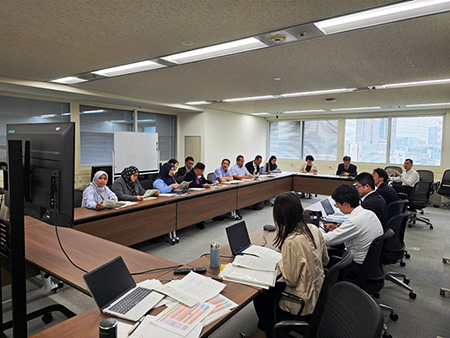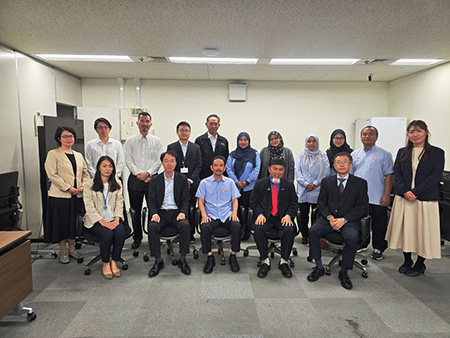On October 20, 2025, an eight-member delegation from Selangor Water Management Authority (SWMA), a NARBO member organization, held a meeting with the Environment Management Division, Environmental Bureau, Ministry of the Environment (MoE), to exchange views on water pollution prevention at MoE in Japan. Japan Water Agency (JWA), NARBO secretariat, organized the meeting with the cooperation of the Institute for Global Environmental Strategies (IGES), at the request of SWMA. In the afternoon of the same day, the delegation also visited the Shibaura Water Reclamation Center (SWRC) in Tokyo with the cooperation of the Tokyo Metropolitan Government Bureau of Sewerage and METAWATER Co., Ltd.
MoE is a government agency responsible for Japan's environmental conservation and development, pollution prevention, and nuclear safety policy, and therefore, is also responsible for Japan's water pollution regulations. IGES is an organization that develops innovative policy methods for sustainable development and conducts policy and practical research to create strategies for environmental measures. METAWATER Co., Ltd. is a comprehensive plant engineering company and the operator that designed and maintained SWRC's wastewater treatment facilities and equipment. These organizations provided considerable cooperation for SWMA's visit to Japan. We would like to express our sincere gratitude to them.
SWMA is a state government agency responsible for the integrated management of rivers and water resources in Selangor. It was established in April 1999 under the Selangor Water Management Act (1999) with the aim of resolving the unclear jurisdiction between federal and state laws and related agencies. Since then, SWMA has worked with state local authorities to improve the quality of the state’s water resources in accordance with the Local Government Act (1976) and the Streets, Drainage and Building Act (1974).
In August 2024, SWMA enacted the Discharge of Return Water, and Entry or Discharge of Waste and Pollutants (State of Selangor) Regulations (2024) that aims to implement the Zero Discharge Policy (ZDP). The purpose of ZDP was to encourage water utilities and companies to make efforts to reduce wastewater discharge and reuse wastewater. During this visit to Japan, SWMA conducted interviews with the MoE, which has jurisdiction over the Water Pollution Control Law, about the implementation record of Japan's wastewater regulations.
1) Date &Time:10:00am – 11:30am, October 20, 2025
2) Venue:Ministry of Environment, Japan
3) Participants
| Ministry of Environment & IGES |
| Name | Job Description | |
| 1 | IZUMI Tomoyuki | Director for International Cooperation, Environmental Management Bureau, MoE |
| 2 | AKAMICHI Mayu | Deputy Director, Environmental Management Division, Environmental Management Bureau, MoE |
| 3 | OHARA Tomoyuki | Section Chief, Office of Environmental Pollution Control, Environmental Management Division, Environmental Management Bureau, MoE |
| 4 | Ngoc Bao Pham | Institute for Global Environmental Strategies (IGES) |
| 5 | Ezra Osorio | ditto |
| 6 | KANAZAWA Sui | ditto |
| 7 | INAMURA Yukako | ditto |
| SWMA & JWA |
| Name | Job Description | |
| 1 | Salim bin Soib @ Hamid | Selangor State Legal Advisor |
| 2 | Ir. Ts. Dr. Mohmad Asari bin Daud | Director of Selangor Waters Management Authority, SWMA |
| 3 | Zarina binti Mhd Hisham | Selangor State Assistant Legal Advisor |
| 4 | Siti Rokiah binti Musa | Selangor State Legal Officer |
| 5 | Haslina binti Amer | Chief Assistant Director River Basin and Costal Management Division, SWMA |
| 6 | Nor Zamri bin Sondor | Chief Assistant Director Planning and Development Division, SWMA |
| 7 | Haizam Irwan bin Toha | Chief Assistant Director Legal and Enforcement Division, SWMAo |
| 8 | Norfazilah binti Shaharubin | Legal Office, SWMA |
| 9 | OTA Michio | Independent Administrative Agency Japan Water Agency |
4) Main subjects of discussion & Results
Q1. How did the prefectures enact or impose additional effluent standards for enclosed sea areas? Was it by passing a new regulation, or by any other processes?
Results
MoE sets minimum environmental water quality standards for the entire Japan. Local authorities (prefectures/municipalities) can establish stricter effluent standards for industrial wastewater facilities through local ordinances. These prefectural-level regulations can be more stringent than national minimums. There is a clear distinction between environmental standards, which are policy goals, and effluent standards, which are regulations.
Q2. Is there any overlap between the following three main laws regarding jurisdiction over the control of the effluent standards?
Basic Act on the Environment 1993/Water Pollution Control Law 1970/Sewerage Act 1958
Results
There is no overlap. The standards set in the Water Pollution Control Law are based on the environmental quality standards established in the Basic Act on the Environment. For instance, the effluent standards for health-related substances are typically set at 10 times the environmental standard. The Sewerage Act aims to achieve the water quality environmental standards established in Basic Act on the Environment through comprehensive sewerage system planning.
Q3. How many prefectures in Japan have imposed additional effluent standards for enclosed sea areas and which are they?
Results
All 47 prefectures have supplemental effluent standards set by local ordinances. These standards may be stricter than the national standards or may apply to facilities that are normally exempt from them. These standards cover not only traditional pollutants such as chemical oxygen demand (COD), but also nitrogen and phosphorus, especially in enclosed water bodies.
Q4. Are there any prefectures where water quality has significantly improved due to a stringent restrictions?
Basic Act on the Environment 1993/Water Pollution Control Law 1970/Sewerage Act 1958
Results
Many prefectures have achieved the environmental water quality standards. Significant improvements in enclosed sea areas (e.g., Tokyo Bay, Ise Bay, Seto Inland Sea) are primarily due to the reduction of industrial and domestic wastewater, driven by the stringent standards and the installation of appropriate treatment facilities. Japan's policy ensures that businesses cannot avoid regulations by relocating, as the same stringent standards generally apply.
Q5. What is the amount of charges that need to be paid by the industries which discharge wastewater into the local authority sewerage system?
Results
All users of public sewer systems (including homes and businesses) are charged a fee. The Ministry of Land, Infrastructure, Transport and Tourism (MLIT) administers the detailed fee structure, but fees based on this system vary by municipality.
● Tokyo (23 wards): The basic fee is ¥560 for up to 8 m3/month, increasing incrementally (e.g., ¥3,288 for 30 m3/month).
● Hachioji City (Tokyo): The basic fee is ¥505 for up to 10 m3/month, increasing incrementally (e.g., ¥2,555 for 30 m3/month).
● Kobe City: In addition to the basic fee and metered rate, users who discharge more than 500 m3/month of high-concentration pollutants (e.g., BOD, SS) are subject to a surcharge based on water quality. The higher the concentration of pollutants, the higher the surcharge, reflecting increased treatment costs.


1)Date & Time:2:00pm – 3:30pm, October 20, 2025
2)Venue:Shibaura Water Reclamation Center (SWRC)
The Shibaura Water Reclamation Center, which began operation in 1931, is Tokyo's third oldest wastewater treatment plant. Once a cluster of dock warehouses, the area has since become a city lined with office buildings. The treatment area covers most of Chiyoda, Chuo, Minato, Shinjuku, and Shibuya wards, as well as parts of Shinagawa, Bunkyo, Meguro, Setagaya, and Toshima wards, covering an area of 6,433 hectares—equivalent to the area inside the JR Yamanote Line.
Treated water (830,000 m³/day) is discharged into Tokyo Bay, but a portion (7,000 m³/day) is purified through biofilm treatment, ozonation, and ceramic filtration processes and supplied to nearby buildings for toilet flushing. The resulting sludge is sent via a pressurized water pipe to the Nanbu Sludge Plant for incineration.
The SWMA delegation arrived at the Shibaura Water Reclamation Center (SWRC) at 2:00 PM, where they received an explanation from METAWATER Co., Ltd. staff below about the retreatment process that allows a portion of the conventionally treated sewage water to be reused as toilet flush water for nearby buildings.
● Imaji Hayashi, Area Manager, International Sales & Marketing Department, International Business Division.
● Yoshi Kanto, P.E. Jp, Senior Manager, International Business Planning Dept., International Business Div.
● Michiko Tamaru, International Sales & Marketing Dept. International Business Div.
METAWATER Co.,Ltd. and the Tokyo Metropolitan Government have collaborated to develop a water reclamation system based on two METAWATER core technologies: the Ozonizer and the Ceramic Membrane. The system was first installed at the SWRC and began operating in April 2010. It enables the production of superior reclaimed water and achieves high filtration quality water.
JWA will support NARBO Organizations for your performance bench markings in Japan. If you want to come to Japan for that, feel free to contact JWA NARBO Secretariat below.
● Mr. ICHIHARA Nobuyuki, Director General for JWA International Affairs
nobuyuki_ichihara@water.go.jp
● Mr. SUZUKI Atsushi, Director, International Division, JWA
atsushi_suzuki@water.go.jp
● Mr. HIGUCHI Tomotaka, Assistant Director, International Division, JWA
tomotaka_higuchi@water.go.jp
● Mr. OTA Michio, Advisor for International Affairs, JWA
micio_ota2@water.go.jp, monarbo7810@gmail.com